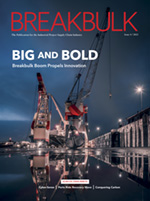Jun 17 | 2021
Technology, Energy Transition, Pandemic Transforming Industry

 By Simon West
By Simon WestWhile gains on productivity are clear, the transition from manual to digital is no easy endeavor, and the industry has not always been quick to embrace change. One executive said to Breakbulk the sector was “old-fashioned” when it came to innovation.
But a confluence of drivers – rapid technological change, energy transition and the upheaval of Covid-19, which has forced forwarders to think and act in a more decentralized way – is transforming how the industry operates.
For breakbulk specialists such as Jumbo and Mammoet, mixed and fully artificial virtual reality are key elements in the digital remodeling of their business processes, but implementing such cutting-edge innovation is not always plain sailing. Jumbo’s deckmarking technology for example has had to be tailored to function better in variable weather conditions, while work is still needed to improve the application’s interface with a cloud-based storage service
‘Dancing and Singing Along’
Developers working on Jumbo’s digital deckmarking solution dubbed it the “Billie Jean” method.
For more than two years, the Netherlands- based heavy-lift shipping line has been rigorously testing the innovation, designed as an alternative to the age-old, time-consuming technique using paper drawings, tape measures and elbow grease.
The system uses Microsoft Holo-Lens mixed reality, or MR, smart glasses to locate predetermined support points on the deck of a vessel prior to loading complex breakbulk cargo. Engineers donning headsets can visualize the cargo’s footprint projected onto the deck, allowing steel shimming plates to be installed at a much faster rate to prevent deflections during transport.
In the style of Michael Jackson in the video of his 1983 hit single, engineers get to see via their headsets deckmarking tiles lighting up as they tread the deck.
“During the development and testing of their software in the office we sometimes saw them dancing and singing along,” said Otto Savenije, senior project engineer at Jumbo. “Personally I have not yet sung the song while working on the ship.”
Late last year, the system was used for the first time for a client when Jumbo transported a 24-meter-diameter carousel from Dusavik to Halden in Norway, the first stage of a job supporting two of offshore engineering firm Subsea 7’s installation projects for Total in Angola.
The carousel, along with a bundle of subsea umbilical cables, tensioners and other auxiliary equipment, weighed 1,255 tonnes, with a shim plan for the job calling for the positioning of 156 separate shimming plates.
“Each plate had to be placed within a couple of centimeters accuracy. This takes normally about half a day or a full day with two to three people. With the HoloLens I could manage it in just over an hour on my own,” Savenije said.
Jumbo is planning to use HoloLens for all of its more complicated deck layouts. The hardware could be applied in the future to show 3D projections of a vessel’s entire cargo, although according to Savenije, capacity and processors need to evolve further to make this technically possible.
Mobile Mapping
Heavy-lift transport specialist Mammoet is also using MR and virtual reality, or VR, to upgrade its working processes, and has combined the technology with its Lidar mobile mapping system to speed up and optimize the transport of project cargo.
In a bid to address the often painfully slow task of route scanning, the Lidar car, equipped with a laser management tool, GPS antenna and a 360-degree ladybug camera, can scan the landscape at speeds of up to 80 kilometers per hour, doing away with the need for roadblocks and traffic measures that can enrage other drivers.
“You can measure every point with an accuracy of up to five millimeters while driving; you do not need to step out,” said Jacques Stoof, head of innovation at Mammoet.
Once Lidar has done its job, 3D data of the environment is processed and images of the cargo to be shifted are drawn up. MR or VR is then applied to simulate how the cargo will be moved along the route, alerting engineers to obstacles or weak infrastructure points.
Mammoet used the system for a recent refinery project in Germany for petrochemical major BASF.
“We got a real scan of the whole area so it was 100 percent accurate, and then we mimicked the actual lift we were going to perform, and with virtual reality glasses we were able to position three individuals at different spots to look at the lift,” Stoof said. “You can actually practice from a safety aspect beforehand what is going to happen tomorrow. I can tell you, it feels real.”
Fast-tracked Innovation
Lars Greiner, associate partner for the Middle East and Africa at Hamburg Port Consulting, or HPC, said many digitalization and automation projects that had been slowly evolving in recent years had been catalyzed by the pandemic.
“Global crises have historically given a push to innovation. I am sure in a couple of years we will look back and see all the innovation jumps currently taking place,” Greiner said. “I believe most had been talked about for a while but had not yet really materialized into actual implementation, and some are still waiting for implementation, but are now at least five years closer to realization than they were just months ago.”
A slew of recently launched digital services for customers, suppliers and other stakeholders is proof that innovation in the breakbulk and project cargo world is alive and kicking and ready to disrupt.
In November, G2 Ocean launched its new online platform, MyG2, aimed at digitalizing the customer’s journey. Customers can now track the geographic location of their cargo during transit or find estimated arrival times through an app on their smartphones.
“The feedback has been very positive,” said Jonathan Harcourt, director of innovation and business development at G2 Ocean. “Since launching, we have registered an increased interest among customers for the new web-based platform. Into 2021, we will continue to onboard customers to the platform as well as developing more functionality, such as cargo booking.”
G2 Ocean is also expanding its use of electronic bills of lading, as disruptions caused by the pandemic have slowed courier services and document deliveries. The Norway-headquartered Company teamed up with blockchain platform provider CargoX in 2019 to trial e-bills to fast-track transferring ownership of cargo.
Blockchain, widely used by cryptocurrencies, is a decentralized ledger that can offer a single contact point for all stakeholders involved in a project. Information is stored in so-called blocks and linked together using secure cryptography.
“We are expecting it to take five-plus years for e-bills to take over from traditional paper bills,” Harcourt said. “A large number of parties involved in the maritime supply chain are accustomed to traditional bills and it takes time and effort to shape behavior and build digital trust.”
Carbon Measuring Progress
Other digital solutions are helping the sector navigate energy transition. As fuel regulations become more stringent and climate goals more ambitious, breakbulk movers are rushing to switch their carbon-intensive practices for more sustainable alternatives.
In April, logistics firm C.H. Robinson launched its free Emissions IQ tool to boost the sustainability of supply chains. The tool allows companies to measure emissions and benchmark their carbon output against others in the industry.
In a pilot project, the tool helped 125 companies reduce their emissions by 350,000 tonnes of CO2 equivalent.
“To cut transportation emissions, companies first need to be able to measure them, but most are not equipped to do that easily across truck, rail, air and ocean transportation,” said Tim Gagnon, vice president of analytics and data science at C.H. Robinson.
“That is where Emissions IQ comes in because without the necessary tools and data, many companies have not been able to pursue carbon reduction at all, or are investing a lot of time and effort that could be automated and eliminated.”
The industry is also seeing innovation in fuel and power production.
Jumbo has a joint venture with GoodFuels to test marine biofuel oil on an offshore decommissioning project, while Mammoet is looking into some pilot projects using hydrogen generators to generate electricity for their cranes.
“We have to become sustainable,” Stoof said. “And we should from our end push the manufacturers to go this way. And if they do not, we should develop things ourselves first and after the suppliers will follow.”
Taking a Practical Approach
But innovation in breakbulk is not confined to digital. Practical solutions too are transforming the sector, such as Jumbo’s bid to replace conventional steel lashings for crew-friendly synthetic versions.
Jumbo and sustainable solutions firm DSM have created an alternative system to secure cargo using Dyneema link chains, which are 85 percent lighter than their steel counterparts. Lashing speeds are twice as quick, reducing vessel turnaround times, while the lighter material helps prevent injuries and limit cargo damage.
One of the company’s ships has been equipped with 120 chains, with plans to roll out the lashings on a project basis. Jumbo’s crews have given the lightweight system a big thumbs up.
“After initial learning to trust the ‘unusual’ light material the crew is highly enthusiastic, especially with the weight reduction, hence less strain,” said Peter Jacobs, senior project engineer at Jumbo. “The main challenge is the awareness of special care to be taken with regards to handling and storage.”
As technology and working processes become inextricably linked and the need to innovate intensifies, companies – even in an “old-fashioned” sector such as breakbulk – are ploughing more of their resources into development in a bid to maintain competitive edge.
Some operators such as G2 Ocean have set up dedicated innovation teams tasked with keeping track of external developments that affect the market.
Others such as C.H. Robinson have launched innovation incubators for creating, testing and scaling solutions for transporting project cargo. The Emission IQ tool, for example, was a product of Robinson Labs, an incubator set up last year to drive “the next big ideas in logistics and supply chains.”
“When you talk about innovation it is such a broad topic at the moment. You start with digitalization and process automation then you go to new fuels and new energy sources. If you can imagine it, you can do it; there are just so many things,” HPC’s Greiner said.“
The smallest changes put in place in an innovation environment can have the most incredible effect.”
Colombia-based Simon West is a freelance journalist specializing in energy and biofuels news and market movements in the Americas.


